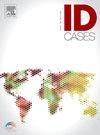Elizabethkingia meningoseptica: Case report on an emerging pathogen and its associated treatment challenges
IF 1
Q4 INFECTIOUS DISEASES
引用次数: 0
Abstract
Elizabethkingia meningoseptica is a Gram-negative bacillus that was previously thought to rarely infect humans but recently has been identified as an emerging pathogen in both community and nosocomial settings. Typically found in the environment, this organism has been shown to infect predisposed hosts with an immunocompromised status and/or a prolonged exposure to healthcare settings. Herein, we report a case of a 78-year-old male with newly diagnosed myelodysplastic syndrome initially admitted to the hospital with pneumonia and then re-admitted after discharge with septic shock and evidence of E. meningoseptica bacteremia isolated from blood cultures. Treatment with piperacillin-tazobactam was initiated and later escalated to dual-therapy with the addition of levofloxacin. After hemodynamic stability was achieved, the patient was discharged on oral levofloxacin to complete a 21-day course of therapy. E. meningoseptica displays a unique multi-drug resistant profile that often makes initial antimicrobial selection challenging. This case illustrates the importance of early detection and use of in vitro susceptibility testing to guide therapeutic decision-making in E. meningoseptica infections; a pathogen known to have both high morbidity and mortality particularly in the immunocompromised.
伊莉莎白脑膜炎败血症:一种新出现的病原体及其相关治疗挑战的病例报告
伊莉莎白氏脑膜炎败血症是一种革兰氏阴性杆菌,以前认为很少感染人类,但最近已被确定为社区和医院环境中的新发病原体。通常在环境中发现,这种生物已被证明感染具有免疫功能低下状态和/或长期暴露于医疗保健机构的易感宿主。在此,我们报告一例78岁男性新诊断骨髓增生异常综合征,最初因肺炎入院,出院后因感染性休克和血培养中分离的脑膜炎脓毒杆菌菌血症再次入院。开始使用哌拉西林-他唑巴坦治疗,后来升级为添加左氧氟沙星的双重治疗。血流动力学稳定后,患者口服左氧氟沙星出院,完成21天疗程。脑膜炎脓毒杆菌显示出独特的多重耐药特征,这往往使最初的抗菌药物选择具有挑战性。该病例说明早期发现和使用体外药敏试验对指导脑膜炎脓毒杆菌感染的治疗决策的重要性;一种已知具有高发病率和高死亡率的病原体,特别是在免疫功能低下的人群中。
本文章由计算机程序翻译,如有差异,请以英文原文为准。
求助全文
约1分钟内获得全文
求助全文

 求助内容:
求助内容: 应助结果提醒方式:
应助结果提醒方式:


